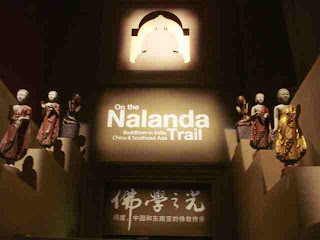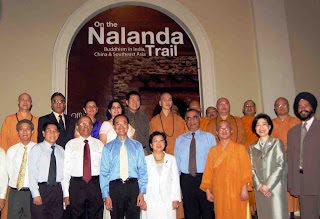[Nalanda Exhibition Opening]
SPEECH BY GEORGE YEO, MINISTER FOR FOREIGN AFFAIRS, SINGAPORE, AT THE OFFICIAL OPENING OF “ON THE NALANDA TRAIL: BUDDHISM IN INDIA, CHINA AND SOUTHEAST ASIA” ON 1 NOVEMBER 2007, 7.00 PM,
AT THE ASIAN CIVILISATIONS MUSEUM
Excellencies, distinguished guests, ladies and gentlemen
1. I am delighted to join all of you this evening for the launch of the exhibition “On The Nalanda Trail: Buddhism in India, China and Southeast Asia”.
2. Nalanda was an ancient town in India which existed during Buddha’s time, and the site of one of the world’s first great universities. The university at Nalanda played a pivotal role in the spread of Buddhism from India to China and Southeast Asia. In its heyday over a thousand years ago, the university was considered an architectural masterpiece, with a sprawling campus dotted with parks and lakes, and dormitories for 10,000 students and 2,000 teachers. The ruins offer a glimpse of what the university used to be. Much excavation work still needs to be done.


3. The influence of Nalanda can be seen all throughout East and Southeast Asia today. A key centre for Buddhist studies, Nalanda attracted great monks from China such as Faxian, Xuanzang and Yijing. Through the overland and maritime silk routes, thousands of sutras were brought back to China. Through Central and Southeast Asia, Buddhism spread from South Asia to China, Korea and Japan. Some of the sutras were translated into Chinese in India; most were translated in China itself. It was a stupendous intellectual effort because the work of translation involved the interpretation of deep concepts from one philosophical framework into another.
4. Well-known Indian monks were invited to China to translate scriptures and establish monasteries. One such monk was Kumarajiva from Kashmir. His translation of the Lotus Sutra from Sanskrit to Chinese during the Tang Dynasty is the basis for the Mahayana Buddhism widely practised in many parts of East and Southeast Asia today. Buddhist values and philosophy have since become an integral part of East and Southeast Asian civilisation.
5. The Government of India has decided to re-establish Nalanda University in Bihar. This idea was mooted by Indian President Abdul Kalam during his state visit to Singapore in early 2006. Following his visit, Singapore hosted the Nalanda Symposium in November 2006. In July this year, the Nalanda Mentor Group, chaired by Nobel Laureate Professor Amartya Sen, held its inaugural meeting in Singapore. I am honoured to be appointed a member of this group in my individual capacity together with experts from India, Japan, the United States, the United Kingdom and China. Prof Sen’s group is guiding the conceptualization and development of the university which will be a centre for learning and an icon of the Asian renaissance. Like the Nalanda of old, the reborn Nalanda should attract scholars from near and far.
6. Last year, PM Manmohan Singh offered Nalanda to the Leaders attending the East Asia Summit as a project to promote international understanding and cooperation. The support that it has received thus far has been heartwarming reflecting the mood of the times. The Buddhist philosophy of man living in harmony with his fellow man and with nature meets a crying need of the 21st century.
7. In Sanskrit, Nalanda means ‘giver of knowledge’. The Nalanda exhibition features a remarkable collection of Buddhist art, including an inscribed plaque from Nalanda which expressed the good bilateral relations between the kings of the Pala dynasty in eastern India and the Shailendra rulers in Southeast Asia. Also not to be missed are rare sutras and paintings from the grottos of Dunhuang.


8. On behalf of the Asian Civilizations Museum and the people of Singapore, I would like to extend my deep gratitude to the Government of India and the Government of Bihar for all the help that they have given to the museum and, in particular, for granting special permission to allow the relics of Buddha from the Piprahwa Stupa near Kapilavastu where the Buddha grew up to be exhibited here. These relics are by regulation not allowed out of India and it was only by special permission that a dispensation was granted us for which we are profoundly grateful. I would also like to thank the Governments of Hongkong and Indonesia for facilitating the loans of other artefacts included in this exhibition.

9. It is now my honour to declare the exhibition open. Thank you.
Do also read my posts on Beyond SG




0 Comments:
Post a Comment
<< Home